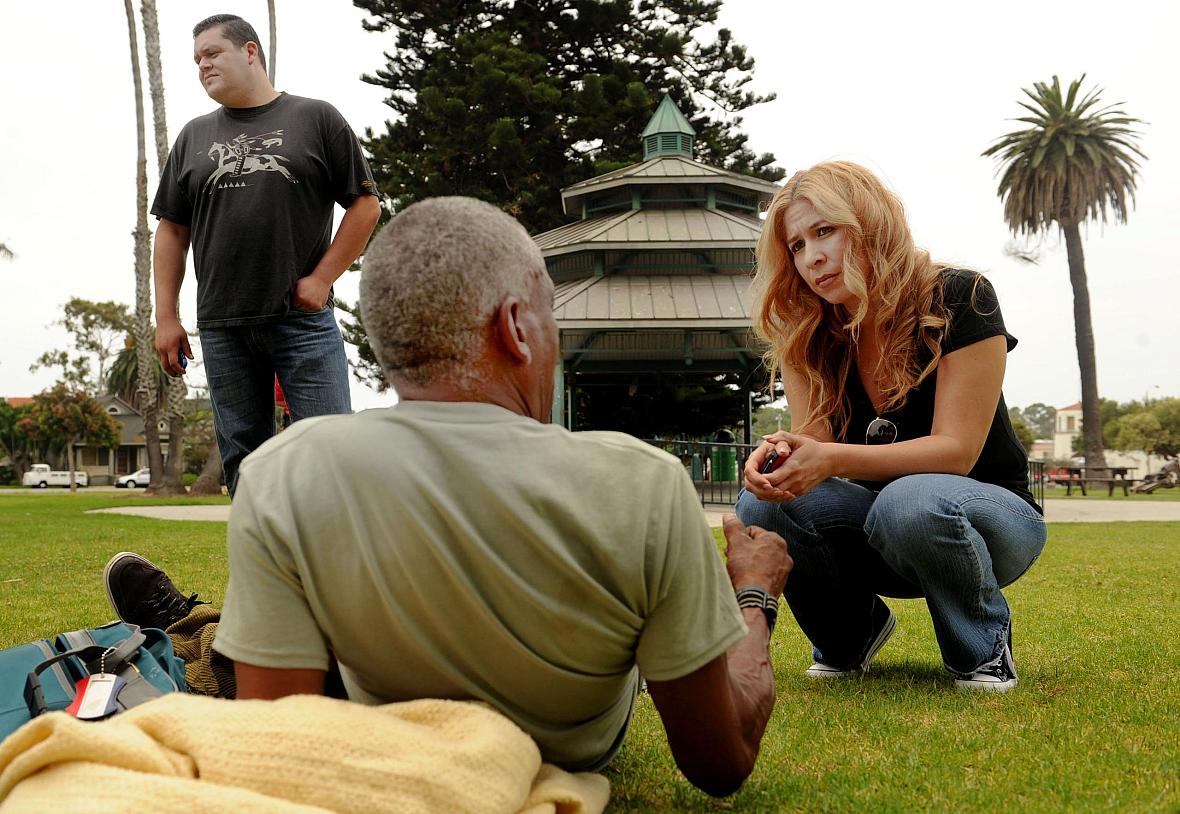Agencies struggle to help homeless who resist services (Part 2)
Claudia Boyd-Barrett is a Southern California-based freelance journalist with an interest in healthcare, poverty issues, immigration and local government. She reported this project as a 2015 California Health Journalism Fellow at the University of Southern California’s Annenberg School of Journalism. Boyd-Barrett currently writes for the Ventura County Star, the California Health Report, and the Jewish Journal of Greater Los Angeles.
Other stories in the series include:
Some chronically homeless people haunted by mental health issues (Part I)
Affordable housing is key to helping homeless (Part 3)
Challenges double when reporting on homelessness and mental health, but a few tips can help

The frail woman with matted hair sat on the steps of Cemetery Memorial Park in Ventura, the summer sun beating down on her.
She wore a bulky plaid jacket, three sweaters, a T-shirt and dirty pajama bottoms. Black socks and sandals smothered her feet. Skin peeled from her reddened face.
“It’s so hot out here,” mumbled the small woman, known only as Leslie to those familiar with her. A passer-by and others in the park didn’t seem to notice.
Officials say some homeless people have severe mental disorders yet remain on the streets for months or even years. Some exist in a quiet state of physical and mental deterioration. Others become noticeably psychotic or, at worst, behave in ways that can threaten others or themselves.
The challenge for social service providers and authorities is that these vulnerable and sometimes volatile people often refuse help, officials said. They might be paranoid and mistrustful of strangers, especially officials. They frequently don’t realize there is anything wrong.
Jacob Jundef, a homeless liaison officer for the Oxnard Police Department, wakes up a homeless man from a fence along a business where he is not allowed.
NO OUTLET
For Kevin Clerici, head of Ventura’s downtown business improvement district, dealing with the chronically homeless is his organization’s biggest challenge.
They wander through the streets and parks. They babble nonsense, have arguments with inanimate objects, perform strange rituals, drink or take drugs in public, and walk around half-dressed.
They might get arrested for a couple of days or taken to hospital, but soon they are back in the public realm, officials said.
"Our system fails," said Clerici. "It doesn't provide an outlet."
People have the right to refuse care. If they are deemed a threat to themselves or others or are gravely disabled, they can be held at a psychiatric hospital for up to 72 hours. In severe cases, and following a hearing, the hold can be extended.
But in most cases, the symptoms that prompt a 72-hour hold clear up quickly and the person is released, said Robert Mendoza, a manager with the county’s Behavioral Health Department.
“Being mentally ill is not a crime,” Mendoza said. “We honor people’s self-determination to live their lives as they choose. If they want to be homeless, then that’s their choice. If they don’t want to be homeless or they’re not in the capacity to really make that decision, then we want to try to help them in that homelessness.”
Mendoza heads a new Behavioral Health program called Rapid Integrated Support and Engagement, or RISE. The program sends out teams of mental health workers to offer help to homeless people. If the person accepts assistance, the team can organize an assessment in the field or get them to a clinic for assessment and treatment. They connect them with a caseworker and follow up with the person for up to a month to make sure they’re keeping their appointments, Mendoza said.
The program, launched this year, is funded in large part by a $7.6 million state grant
Mendoza said teams have contacted 1,220 people so far, but he doesn’t yet have statistics on how many accepted help. He said teams often have to meet with the clients multiple times to gain their trust. The teams will keep trying to engage resistant people for up to a year, he said, but if they persistently refuse help, officials eventually will move on.
"We believe we're making good progress. But remember, these are the most difficult folks," he said. Each success story represents "a lot of effort, sometimes it's weeks of engagement, follow-up calls, missed appointments and then bringing them back. It's very labor intensive."
MULTIAGENCY EFFORT
The people sitting at a table at the Ventura Police Department last month provided a snapshot of how many agencies are dealing with the chronically homeless.
There were police officers, state park rangers, a public defender, a hospital caseworker, Ventura’s city attorney and community services manager, a therapist with RISE, and caseworkers with the Salvation Army and two other nonprofit groups.
They’d gathered, as they do every Tuesday, to discuss one of the most vexing problems for public officials, law enforcement and social service providers: how to help homeless people who won’t help themselves.
Carina Cervantez, a community service coordinator for Ventura County Behavioral Health, tries to help a homeless woman at Cemetery Memorial Park in Ventura.
The weekly meeting is part of the city of Ventura’s Community Intervention Court program. The program, run in partnership with Ventura County Superior Court, attempts to divert chronically homeless lawbreakers from the criminal justice system to social services by allowing them to accept substance abuse or mental health treatment, as well as housing assistance, in lieu of jail time.
Participants typically face charges for vagrancy-related violations such as illegal camping, drinking in public or disturbing the peace. Most are ordered into substance abuse or mental health programs, said Ventura police Sgt. Jerry Foreman.
“We knew we weren’t going to be able to just arrest our way out of the problem,” said Foreman. “We want to change their behavior. They don’t belong in jail.”
It’s difficult work. Many of the homeless who agree to enroll in the program don’t follow through on the judge’s order for treatment and end up back in jail or on the streets. Of 27 participants who signed up for the program in the past six months, just seven have stayed with it, Foreman said. One of those has graduated, meaning he is stable and no longer needs assistance, Foreman said.
[This story was originally published by the Ventura County Star. Photos by Juan Carlo.]

